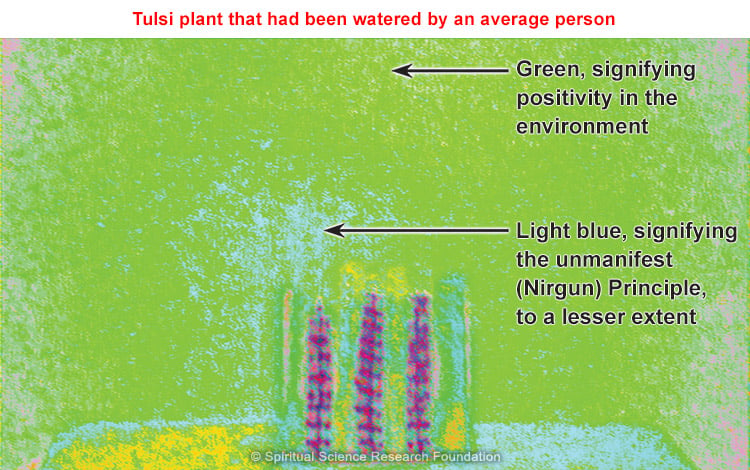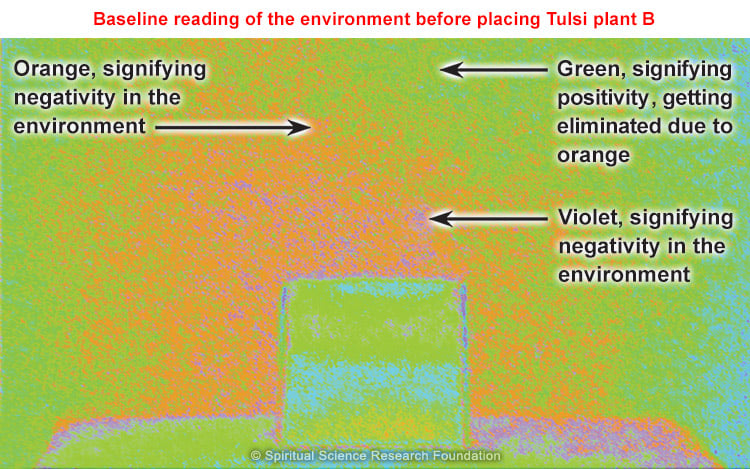Register to Attend Our In-Person Events
Benefit from this unique opportunity by joining our events and meeting Her Holiness Bhavana Shinde in a city near you !
Meet SSRF on our Europe Spiritual Tour !
Immerse yourself in our insightful lectures on karma, healing, growth and more.
Join our Chanting Meditation session to experience calmness and relaxation.

1. Introduction to a study about the spiritual benefits of Tulsi or Holy basil
Tulsi (Ocimum tenuiflorum) or Holy basil is regarded as the holiest of all plants. The plant is cultivated for religious and medicinal purposes, and for its essential oil. It is widely known across South Asia as a medicinal plant and commonly used in Ayurveda. Ayurveda is a system of traditional medicine native to the Indian subcontinent and is a form of alternative medicine.
A study was conducted by the Spiritual Science Research Foundation (SSRF) to see the effect of a Tulsi plant on the environment. SSRF conducted a further test to see if there was any impact on the environment due to the Tulsi plant depending on who watered the plant. Two Tulsi plants were used in the experiment:
- Tulsi plant A: This Tulsi plant has been watered by an average person
- Tulsi plant B: This Tulsi plant has been watered by His Holiness Dr. Athavale, a Saint above the 90% spiritual level.
The spiritual level of a person can only be ascertained through the medium of an advanced sixth sense. However to study the effect of the Tulsi plant on the environment, SSRF used two biofield imaging machines which are Resonant Field Imaging (RIF) and Polycontrast Interference Photography (PIP).
2. Background information about Tulsi plant and Saints
The average spiritual level of a person not doing any spiritual practice in the current era (Kaliyug) is between 20 to 25%. When a person starts spiritual practice and makes efforts consistently on a daily basis his spiritual level gradually increases. When the spiritual level of a person reaches 70% the person is considered to have attained Sainthood. The spiritual level of 100% means that the person is completely merged with the God Principle.
The spiritual level of a person is also a function of the proportion of the three subtle components that a person is made up of. The higher the Sattva component, which represents the spiritual purity in a person, the higher is the spiritual level of the person. Due to the high level of sāttvikta present in Saints, they positively affect everything and everyone by their mere presence. As H.H. Dr. Athavale is a Saint of the highest level, it has been observed that many objects used by Him are showing visible changes due to the Divine conciousness emanating from Him. Read more about the phenomenon on progressive changes in objects due to positive spiritual energy.
Through spiritual research SSRF has found that the Tulsi plant has the highest levels of the Sattva component amongst plants. In October 2013 Divine particles had appeared for many days on every leaf of the Tulsi plant that H.H. Dr. Athavale watered each day on His balcony. This was due to the plant being exposed to the Divine conciousness emanating from H.H. Dr. Athavale.
3. Analysis using a biofield imaging machines
If one has an above average sixth sense ability, one can easily perceive the spiritually pure nature of the Tulsi plant watered by H.H. Dr. Athavale and the positive vibrations that it emanates. Some biofeedback equipment such as the RFI (Resonant Field Imaging) and PIP (Polycontrast Interference Photography: a biofield imaging type of equipment) are able to pick up the vibrations around an object and display it in a visual format. This gives an average person the opportunity to visually see the aura or energy field of an object and its surroundings.
3.1 The RFI readings
|
Measurement of: |
The reading |
What it means |
|---|---|---|
|
The vicinity prior to placement of the Tulsi plant watered by an average person |
121.2 MHz |
The colour of this frequency as per the RFI is orange which indicates the presence of Tama predominant vibrations or spiritually impure vibrations. The Tama subtle component signifies spiritual impurity and refers to spiritual ignorance and inertia. |
|
The vicinity on placing the Tulsi plant water by an average person |
121.2 MHz |
Its corresponding colour on the RFI chart is orange and it denotes pressure and negativity in the environment. |
|
The vicinity of the Tulsi plant watered by H.H. Dr. Athavale |
125.0 MHz |
Its colour is golden and it signifies a higher level of positive vibrations. |
3.2 The PIP readings
Using the PIP biofield imaging device we took three readings which were:
-
The environment with no Tulsi plant
-
The environment with a Tulsi plant that had been watered by an average person
-
The environment with a Tulsi plant that had been watered by H.H. Dr. Athavale
Let us now examine each of the auras displayed by the PIP biofield imaging device.
3.2.1 The environment with no Tulsi plant
This is an aura image of the environment when it was empty and no Tulsi plant had been placed. As one can see from the picture below, the main colours seen are orange and violet, which indicate negativity. The colour green, which indicates positivity, has been pushed back due to the orange. This was the baseline reading of the environment before we placed Tulsi plant A.
3.2.2 The environment with a Tulsi plant that had been watered by an average person – Tulsi plant sample A
In the next stage of the testing, a Tulsi plant that had been watered by an average person was introduced into the same environment. As one can see from the diagram below, there is a significant change in the aura in a matter of five minutes. The negatively associated colours have dissipated and colours that are considered positive such as green and traces of light blue are predominantly seen. This shows that a Tulsi plant has a positive impact on the environment.
The environment after the Tulsi plant watered by an average person and before placing the Tulsi plant watered by H.H. Dr. Athavale
3.2.3 The environment with a Tulsi plant that had been watered by H.H. Dr. Athavale – Tulsi plant sample B
Finally the normal Tulsi plant was removed and replaced by the Tulsi plant that had been watered by H.H. Dr. Athavale. As one can see from the aura picture displayed below, there is a significant increase in the amount of the colour light blue. Light blue as per the PIP biofield imaging device is considered even more positive than green. This shows that the Tulsi plant watered by H.H. Dr. Athavale was far more positive than an ordinary Tulsi plant.
3.2.4 Summary of conclusions and significance
In this experiment the results of the biofield imaging devices only endorse the findings obtained through sixth sense about the spiritual purity of a Tulsi plant and the immense benefit of the presence of a Saint. The following are the key points established by the experiment.
-
The Tulsi plant is highly positive and has a positive effect on the enviroment in a short period of time.
-
Growing a Tulsi plant in one’s home or garden will have a spiritual healing effect on the environment which in turn benefits the residents of the premises.
-
If one does spiritual practice then as one’s spiritual level grows, the environment is affected positively.
-
When a person attains the spiritual level of a Saint then by His or Her mere presence people and objects in the vicinity are infused with spiritual positivity.
The above scan and analysis has been done with the help of Mr. Santosh Joshi (Universal Energy Researcher, Mumbai, India).










